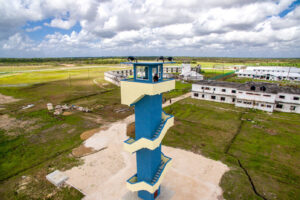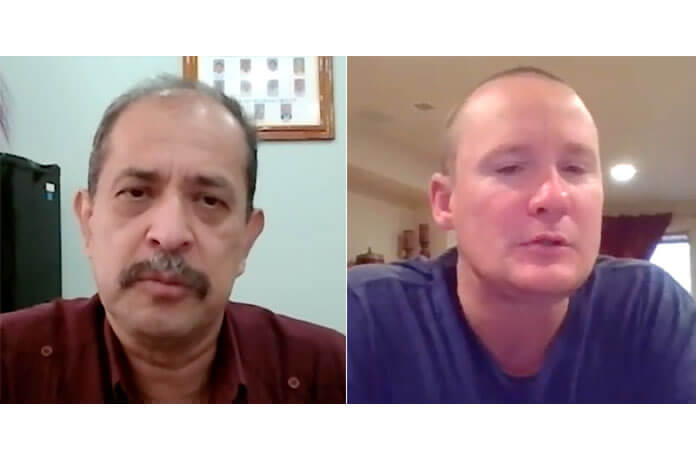(continued from page 27 of Amandala, Fri. Feb. 12, 2021)
BELIZE CITY, Wed. Feb. 17, 2021– During the interview with Amandala, CEO Murillo shared that there had been no notable increase of tension inside the prison or deterioration of relations between inmates and guards at the time of the prison break, notwithstanding the imposed lockdown which triggered a halt in all in-person visits to inmates: “I am certain that, yes, they may have wanted to attribute it to the COVID-19 scare, but I don’t pick up on that. My analysis is that at that time the prison had a little over 1,200 inmates, and you will tell me that only roughly 60 of them decided to get ballistic about COVID? I mean, come on, the entire prison was at risk of this COVID-19.” CEO Murillo said.
On October 28, officials at the Belize Central Prison suddenly became aware of an impending health crisis at the prison after 90 cases of COVID-19 were recorded inside the facility in one day — an explosive discovery. CEO Murillo opined that this outbreak could have been more of a catalyst for a mass escape or riot inside the prison if the coronavirus was the major concern of the inmates.
CEO Murillo explained, “This is why I think we were caught totally off-guard. Because the temperature at the time was not indicating that there was anything looming. We had that continuous mutual respect and understanding among guards and prisoners, and the prison was pretty much functioning very well. I know that they missed their visits and their drop-offs, but they were still getting cash deposited into their accounts.”
In order to obtain an alternate perspective on the circumstances at the prison at the time of the riot and escape, Amandala spoke to a former inmate and trustee this past weekend, who, in his description of the conditions at the prison prior to both the pandemic and the jail break, confirmed some of the observations that Murillo had made — in particular, Murillo’s belief that the lack of availability of marijuana in the prison could have been the cause for the jailbreak. He described to us, just as CEO Murillo had done, a system that is in place inside the prison to transport marijuana and other illegal substances around the facility.
This system was brought to its knees when the prison entered its total lockdown. The former inmate, who chose to remain anonymous, also pointed to other effects of the lockdown — in addition to the cutoff in the marijuana supply. He explained that the discontinuation of in-person visits meant that inmates would have had to make do with the little food and rations apportioned to them by the Kolbe Foundation, which in normal circumstances, are insufficient for a grown man, he said.
He shared that this added frustration could have contributed to an abrupt increase in tensions and a heightened mood of resistance among the inmates, who then planned and executed the prison break just before the scheduled total lockdown of the facility.
In early December 2020, after the prison’s initial investigation into the riot and escape was completed, five staff members of the facility, including one prison guard, were fired. At the time, CEO Murillo told 7News that it was discovered that those staff members had been involved in the escape, and in some instances, had directly contributed to the inmates’ efforts.
As mentioned earlier, those persons have since been fired, and the prison has implemented security measures among prison guards and inmates to ensure that such collusion never occurs again.
But are those measures in place enough?
Both CEO Murillo and the former inmate said that inside the prison, the relationship between staff, prison guards, and inmates is in many ways, a cordial one. The former inmate told us that various staff members and prison guards have played pivotal roles in the relay system used to transport drugs and other illegal substances across the prison. He also mentioned that some prisoners developed special relationships with the prison staff to “get ahead” inside the facility.
CEO Murillo said that the good relationship between the prison guards and inmates could have been seen at the time of the riot. As had been reported by the media, one inmate commandeered an assault rifle from a guard and proceeded to climb a tower. Murillo pointed out that, with this deadly weapon and an elevated line of sight, the inmate could have killed several prison guards if the prisoners harbored any personal grievances.
“Remember what happened in this thing. This was a hostage-taking-turned-escape situation. Remember they took away the gun from the guard. They could have used that gun and killed off all the prison officers at the back there. That never happened! So, to me, that speaks volumes, because that tells you more or less the relationship. If there was any hostility, if there was any hatred, I know they would have shot off all those guys, kill[ed] them.” CEO Murillo said.
And while the staff and inmates at the Belize Central Prison have developed a relationship that serves their mutual interests, the former inmate with whom Amandala spoke, remarked that the conditions inside the facility can either make or break a person.
He told us that the treatment of prisoners is, in some instances, to him, inhumane, and must be addressed.
The former inmate, who, as mentioned, was also a trustee and food distributor at the facility, said that each morning inmates should get a 4-ounce portion of bread for breakfast. This is served with a cup of tea, sugar, water, and cocoa powder. Of note, he mentioned that instead of the 4-ounce portions of bread, prisoners often receive a smaller 2-ounce roll. He said that this is also the case in the evenings: when they are supposed to receive an 8-ounce piece of bread, they only get a smaller, 4-ounce portion. A typical meal at lunchtime would consist of boiled chicken, or corned beef, with rice and beans, the former inmate said.
The former inmate also mentioned that prisoners who have a support system on the outside hardly ever eat the food provided to them by the prison. The family members and friends of these prisoners often bring groceries and water when they visit these inmates. These visits had to be discontinued at the time of the total lockdown, however, and as a result, some of these inmates were forced to consume the food provided to them within the facility. This was an additional source of frustration that could have triggered the escape and riot, said the former inmate.
At this time, the Belize Central Prison receives $14 BZD daily for each inmate, compared to an estimated $99 USD per inmate received by US prisons, according to Dr. Sadulski.

“We’ll go back to the money the prison receives: $7 USD per day in Belize. In the United States, that number is closer to $99 per day in the federal system, according to the Bureau of Prisons. So just imagine, with such a significantly smaller budget, what’s occurring in terms of recidivism. The recidivism rate is far lower at the Belize Central Prison than it is in most other prisons throughout the world. In addition, if we look at the level of control, when I say control I mean the level of success in daily operations within the prison. In the Belize Central Prison, compared to other prisons in the region, if we look at some of the prisons in, say, for example, Honduras. Those in Honduras are primarily run by the cartels within the prison; we don’t have that level of conflict between the staff at the Belize Central Prison and the inmates. There is definitely a level of discipline and control and order within the Belize Central Prison that is greater than what I’ve seen in the other prisons I’ve studied,” Dr. Sadulski commented.
While the Belize Central Prison continues to operate with a very meager budget, CEO Murillo vowed that they would press on with their mandate, despite the hardships. He admitted that, given the current economic predicament of the country, they are not expecting any increase in their budget allocation, although there is always a need for resources.
“We are lacking in just about everything. We’re lacking in financial resources. We do have infrastructure that we would want to improve to improve the overall security of the facility. As we go along, we are doing whatever we can afford to do, because the prison does have some industries that generate little funds. But I will tell you something, those industries are pretty much offsetting the bills for the rehabilitation of the prisoners for teaching them a skill,” CEO Murillo said.

